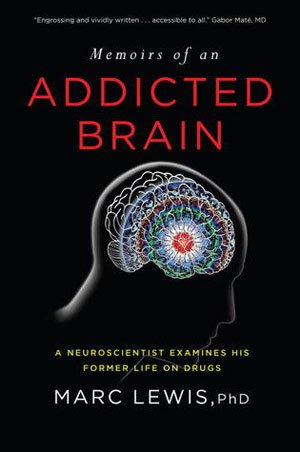
Long Path to Battle Drug Addiction
3 September 2020
Quebec Man’s Stroke Cures His Cocaine Addiction
3 September 2020Dr. Marc Lewis’ Memoirs of an Addicted Brain: A Neuroscientist Examines His Former Life on Drugs Provides Addiction Autobiography, Explanation, and Theory
Marc Lewis, once opiate addict, now developmental neuroscientist, has just published an autobiographical account that details the life of an addict who started with alcohol and cough syrup as a kid and made his way through LSD and opium and heroin as an adolescent and adult. But Lewis has also delivered in this same work an elaboration on how and why he and so many of us have come to be addicted—by explaining in his book the science behind the brain on alcohol, on psychedelics and psychotropics, and on opiates.
As he explains in the memoir, with all “goodies”, such as is the case with the drug/s he got hooked on heroin/opium (and other opioids), the brain’s natural feel-good chemicals like dopamine are what give us the good feeling, make us like what we are feeling, but then are responsible, too, for making us crave more/seek more of that feeling: “Natural goodies like food and sex certainly follow the progression from liking to wanting. Feels good—want more. But with goodies both natural and acquired, it is dopamine’s flame of desire, unleashed by the ahhhhh of opioids that causes animals to repeat behaviours that lead to satisfaction.
In the case of a boy who at fifteen had begun his descent into a personal world “gutted by depression,” the components responsible, the opioid receptors (located in the hypothalamus, the amygdala, the brain stem, etc.) are powerful agents facilitating the feel-goods: they are so potent in assigning the tendency for drug addiction because, Lewis explains, they are found in a multitude of places and because they address and assuage the multileveled forms of suffering “that are psychologically susceptible to opioid relief.”
But Memoirs of an Addicted Brain is not pure high-science material. The book is balanced with such explanation and the many malaises, miseries, and misadventures that a young man experienced and that addicts experience—the depression, the loneliness, the finally feeling “cheerful” after getting high on alcohol; the pleasure of heroin that results in sensations of “a warm syrup…,” in a state where “There is no sleepiness, no drowsiness…,” a state whereby, “Outside of [him] nothing exist[ed];” the addict’s mad cycle of such sought-after highs, highs that are pursued with such intensity, he says, one is “willing to do anything” to get them.
As he writes in his intro, drugs can teach us a lot about the brain, and what we know about the brain can teach us a lot about addiction.” But as he does throughout the memoir, Lewis narrates the experiences and expresses the feelings and needs of the addict-in-himself as well as the addicted brain’s feelings and needs. So, for example, as he tells readers about his needing to escape the depression and loneliness of prep school (and the bullies who tormented him) by using drugs/alcohol, as he relates his stories of attending college at UC Berkeley and later of attending and being ousted from University of Windsor (for stealing drugs), he also outlines the biochemical activities taking place to instigate all of the above: for instance, he explains how the natural opioids of the brain’s hypothalamus function in three ways, “to provide relief from pain or stress, to produce a sense of pleasure or well-being that can energize any goal, and to use either or both of these feelings-relief and/or reward-as the emotional currency of human attachment.”
So, collected in four parts with fifteen chapters, Memoirs of an Addicted Brain brings to lay readers The Tabor Chronicles, set at a private para-naval academy for boys in New England and outlining the human and psychological influences and the personal experiences and emotions that the author implicitly explains contributed in some way to his developing an addiction that lasted most of his life to date; Life and Death in California follows the author’s studies at UC Berkeley and his acid/heroin/mescaline experiences in the city and in San Francisco in 1968 on; Going Places tracks his experiences in Asia (Malaysia to Calcutta) with the opiate family as it continues to plague the craven with the great grand-daddy of the opiate family, opium; and In Sickness and in Health relates the down-turning depths of depravity in the experiments and exercises in drug addiction, drug stealing, and consequences of both. But at the same time, Memoirs of an Addicted Brain steps outside of itself, or the memoirist steps out of his personal history, and Lewis dons the analytical hat of the [clean and sober] neuroscientist he finally became to examine the want, then the need, then the must-have of the addicted brain as it is neurochemically programmed to crave chemicals to feed the “cycle of craving” of the addicted brain.
Memoirs of an Addicted Brain: A Neuroscientist Examines His Former Life on Drugs was published on October 4th 2011. There were many reviews since then praising the work as a both literary and scientific achievement—a work praised by many as, writes University of Amsterdam’s Emeritus Professor of Psychology, Nico H. Frijda, “a splendid, moving, and highly informative book on drug addiction.” A work James Olds Collegiate Professor of Psychology and Neuroscience at University of Michigan, Kent Berridge, exclaims, “vividly conveys the alluring yet dangerous universe of mind-altering drugs and the painful paths of addiction and recovery.” A work physician and best-selling author Gaber Maté sums up as “…illuminating to experts, accessible to all.”




